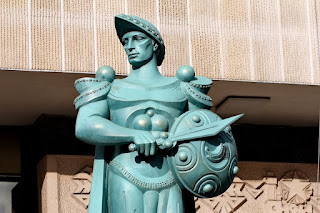In Hittite texts the death of a king not only was
considered taboo word but the entire fabric of words
was designed to avoid offending the monarch. Hittites
used the expression 'the king became a god' instead of
'the king died'. As a sign of respect Hittites added
ubiquitously the suffix -ili to the name of a king to
solidify the worship of a king even while he was alive.
This particular suffix meant 'god' among Semitic people
adjacent to the Hittites. Near the ancient Wilusa in Asia
Minor lived Dardanians, an Illyrian tribe. The founders
of Ilios, Illyrians used the same practice as Hittites to
deify their own kings. The origin of Indo European suffix
-ili 'god' is in the ancient Uruk, the kingdom of
Sumerians who regularly added the title of Enlil to the
name of a king.
It is obvious that Indo European sun god was created
after the Sumerian god Enlil. Enlil, lord wind,
Mesopotamian (Sumerian) [Iraq], is god of the air. He
was worship from 3500 BC, or before, to about 1750
BC. The son of primordial An and Ki, Enlili was the
tutelary deity of Nippur where, in his honor, the Ehur
sanctuary was built, not rediscovered, and he became
the most important god of southern Mesopotamia
during the third millennium BC. His consort was Ninlil
who was impregnated by the "waters of Emlil" to give
birth to the moon god Nanna. (In the Akkadian
pantheon his consort becomes Mulliltu.) He is depicted
in a horned headdress and a tiered skirt, or by a horned
crown on a pedestal.
According to the Hymn to Enlil, he works alone and
unaided. He is said to have made the pickax, "caused
the good to come forth," and "brought forth seed from
the earth." He was invoked to bless his cities to ensure
prosperity and abundance. So great was his importance
that other tutelary deities were said to have traveled to
Nippur to give Enlil offerings. Enlil created several
deities concerned with the overseeing of the natural
world. In his destructive aspect, he permitted the birth
goddess to kill at birth and was responsibility for
miscarriages in cows and ewes. His believers saw him
manifest himself in both benevolence and destructive
violence. His natural status was gradually decreased in
the Babylonian and Assyrian pantheons, being
superseded by Marduk and Assur. A.G.H.
Enlil
by Micha F. Lindemans
In ancient Sumero-Babylonian myth, Enlil ("lord wind")
is the god of air, wind and storms. Enlil is the foremost
god of the Mesopotamian pantheon, and is sometimes
referred to as Kur-Gal ("great mountain"). In the
Sumerian cosmology he was born of the union of An
heaven and Ki earth. These he separated, and he
carried off the earth as his portion. In later times he
supplanted Anu as chief god. His consort is Ninlil with
whom he has five children: Nanna, Nerigal, Ningirsu,
Ninurta, and Nisaba.
Enlil holds possession of the Tablets of Destiny which
gives him power over the entire cosmos and the affairs
of man. He is sometimes friendly towards mankind, but
can also be a stern and even cruel god who punishes
man and sends forth disasters, such as the great Flood
which wiped out humanity with the exception of
Atrahasis. Enlil is portrayed wearing a crown with horns,
symbol of his power. His most prestigious temple was in
the city Nippur, and he was the patron of that city. His
equivalent is the Akkadian god Ellil.
Ellil
by Micha F. Lindemans
The Akkadian god of earth and wind. He is the son of
Ansar and Kisar, the primordial deities, and the father
of the moon god Sin. Together with Ea and Anu he
forms a powerful triad of gods in the ancient
Mesopotamian religion. He is represented wearing a
headband which is decorated with horns. He is
equivalent to the Sumerian god Enlil.
Ellil is one of the most important gods of Mesopotamia.
Ellil is so powerful that the other gods can't even look
at him. He is therefore only shown as a horned cap. The
Hebrews called him Elohim which means basically god.
What is striking about the list of Sumerian kings is that
the kings are divided into two groups - those who ruled
before a great flood and those who ruled after it.
Equally striking is that the lengths of the reigns (and
life spans) of these kings drastically decreased after the
flood, as did life spans of people recorded in the Bible.
The very idea of a monotheistic god, the very fabric of
Judaism and then Christianity was actually based on the
Babylonian hierarchy of gods where Enlil was the god of
air, land, earth, and men's fates. He later became the
head of the gods. He was responsible for the Great
Flood. Since all Indo European languages use the same
root lemma for the sun god identical with Ellil, this is a
proof that all Indo European languages derive from the
same ancestor language spoken in Asia Minor. Illyrians
could have been the first Indo Europeans to worship a
sun god called Ellil. The simultaneous practice of Hittite
and Illyrian priestly class to call a king Enlil means that
those people shared the same kingship, the same
customs and origin.
The first recorded Illyrian king was Hyllus (The Star)
whose death was recorded in 1225 B.C. The deification
of the first Illyrian king corresponds to the rein of the
last Hittite king. The ancient custom of king deification
was subsequently revived after the death of Bardylis
who reigned from 385 to 358 BC. The deification
tradition was refreshed after the death of Bardylis II -
attested in 295 to 290 BC. There was another
deification of Mytilius- attested about 270 BC. The last
king to be deified was Skerdilaidas - who reigned from
212 to 206 BC. In Latin, Albanian and other Indo
European tongues -il suffix lost its divine value and
became a diminutive, marking affection.
The Illyrian King List
Hyllus (The Star) whose death was recorded in 1225
B.C.
Bardylis - Usurper and founder of this dynasty. Reigned
385 to 358 BC.
Grabus - Attested in 356 BC.
Pleuratus - Testified in 344 BC.
Kleitus - Son of Bardylis. Attested in 335 BC.
Glaukias - Ruler of the Taulanti and then Illyrian king
from 317 to 303 BC.
Bardylis II - Attested in 295 to 290 BC he was the son of
Kleitus.
Monunius - Attested in 280 BC.
Mytilius- Attested about 270 BC.
Pleuratus - Founder of this dynasty. Attested in 260 BC
(?).
Agron - Son of Pleuratus. Reigned from 250 to 230 BC.
Pinnes - Reigned from 230 to 217 BC.
Skerdilaidas - Reigned from 212 to 206 BC.
Pleuratus - Son of Skerdilaidas. Reigned from 205 to
180 BC.
Gentius - Son of Pleuratus. Ruled from 180 to 168 BC.
Illyrians were not the first people to identify their king
with a god. Virtually every great civilization employed
the device of deification of its kings. Other cultures,
namely Sumerians, Egyptians based their entire fabric
of their society around a king who was believed to be
god on earth. Yet of all Indo European people only
Hittites and Illyrians employed the -ili suffix to denote
the sacred nature of a dead king. Since the custom of
calling a king 'god' came from Asia Minor it is natural to
believe that Hittites and Illyrians stemmed from the
same craddle of civilization. The elevation of kings to
the status of a god is the tip of the iceberg since
Illyrians (Albanians) and Hittites share their basic Indo
European inherited root words. Both Hittites and
Illyrians use the epithet alba 'white' to classify the
white race of indo Europeans. Illyrians were named
after their kinship to Ilios, Wilusa in Hittite texts. But
they were also named Albanians 'white people' in
contrast to other colored races in Mesopotamia.
ALBANIAN AN ILLYRIAN DIALECT
Ancient civilizations were organized around city states.
People who lived around those city states were often
named after the capital of their kingdom. Romans were
initially called Latin but their name changed after their
introduction of Romulus’ myth (the legendary founder
of Rome) in the Etruscan capital of Alba Longa. Hittites
were named after their capital Hattusas and their
deified king was called Hattus-ili. Similarly Athenians
were named the champion of their city, goddess
Athena. Albanians (as one of innumerous Illyrian tribes)
were named after their city state Albanopolis near a
mountain called Alp 'mountain', Hittite alpa 'white'. The
most spectacular name belonged to Dardanus (founder
of Troy) because it is related to the myth of the Great
Flood (which allegedly took place after the last ice age)
hence it should be one of the oldest tribal names
among Illyrians who like Greeks, Celts and Romans
were obsessed with their divine ancestry. The origin of
gods and myths of creation were not pure fantasy but
instruments for survival. Ancient people were divided
into two categories - those who were condemned to be
slaves and those who were born to rule. Those people
who failed to come up with a convincing divine lineage
were often condemned to be slain, mutilated and
exterminated. There was no mercy for godless
ancestors. That is why Greeks embraced Hellen,
Illyrians adored Hyllus and Romans worshiped Romulus.
People even altered the myths, changed the names,
ignored their real ancestors and abandoned inherited
names to adopt new idols which were more fashionable
at that time. It seems that the name Albania 'white'
was not attractive enough to Albanians since it didn't
carry any significant weight. Actually the descendants
of Illyrians preferred another name - the imperial
double headed eagle. Romans had always employed
the single head eagle as their military ensign or
standard. When Illyrian generals got elevated to the
imperial throne they introduced the Hittite double
headed eagle they had inherited from their Anatolian
ancestors. (There is still a mountainous region in
Albania called Hoti similar to ancient HATTI - the capital
of Hittites.)
Hittites together with Persians probably borrowed the
symbol of double headed eagle from an older
civilization - Sumerian. Here there is the image of the
double headed eagle at Persepolis - capital of the
ancient Persian Empire.
The final proof that Illyrians had employed the double
headed eagle before they introduced that symbol to
Roman standards exists in the city of Sirkap (Pakistan).
Along the main street of Sirkap, the ancient city, sits
the Double-Headed Eagle Shrine. Its original name is
lost, but is now referred to as the double-Headed Eagle
Shrine because of the bird bas-relief that adorns the
arch (images two and three). The Double-Headed Eagle
Shrine was built by Macedonian, Greek and Illyrian
soldiers. Alexander the Great employed Illyrian and
Greek troops in his campaign to India.
The eagle was considered to be the sacred bird of
Jupiter - the sky god among Indo Europeans.

